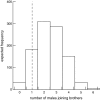Do Dispersing Monkeys Follow Kin? Evidence from Gray-cheeked Mangabeys (Lophocebus albigena)
- PMID: 21475401
- PMCID: PMC3047692
- DOI: 10.1007/s10764-010-9483-6
Do Dispersing Monkeys Follow Kin? Evidence from Gray-cheeked Mangabeys (Lophocebus albigena)
Abstract
Among social vertebrates, immigrants may incur a substantial fitness cost when they attempt to join a new group. Dispersers could reduce that cost, or increase their probability of mating via coalition formation, by immigrating into groups containing first- or second-degree relatives. We here examine whether dispersing males tend to move into groups containing fathers or brothers in gray-cheeked mangabeys (Lophocebus albigena) in Kibale National Park, Uganda. We sampled blood from 21 subadult and adult male mangabeys in 7 social groups and genotyped them at 17 microsatellite loci. Twelve genotyped males dispersed to groups containing other genotyped adult males during the study; in only 1 case did the group contain a probable male relative. Contrary to the prediction that dispersing males would follow kin, relatively few adult male dyads were likely first- or second-degree relatives; opportunities for kin-biased dispersal by mangabeys appear to be rare. During 4 yr of observation, adult brothers shared a group only once, and for only 6 wk. Mean relatedness among adult males sharing a group was lower than that among males in different groups. Randomization tests indicate that closely related males share groups no more often than expected by chance, although these tests had limited power. We suggest that the demographic conditions that allow kin-biased dispersal to evolve do not occur in mangabeys, may be unusual among primates, and are worth further attention.
Figures
Similar articles
-
Patterns of male residency and intergroup transfer in gray-cheeked mangabeys (Lophocebus albigena).Am J Primatol. 2005 Aug;66(4):331-49. doi: 10.1002/ajp.20160. Am J Primatol. 2005. PMID: 16104031
-
Correlations between social context and fecal glucocorticoid metabolite concentrations in free-ranging female gray-cheeked mangabeys (Lophocebus albigena) in Kibale National Park, Uganda.Folia Biol (Krakow). 2013;61(3-4):239-46. doi: 10.3409/fb61_3-4.239. Folia Biol (Krakow). 2013. PMID: 24279175
-
Reproductive tactics influence cortisol levels in individual male gray-cheeked mangabeys (Lophocebus albigena).Horm Behav. 2009 Jan;55(1):210-6. doi: 10.1016/j.yhbeh.2008.10.004. Epub 2008 Oct 21. Horm Behav. 2009. PMID: 18996388
-
Paternal kin discrimination: the evidence and likely mechanisms.Biol Rev Camb Philos Soc. 2007 May;82(2):319-34. doi: 10.1111/j.1469-185X.2007.00011.x. Biol Rev Camb Philos Soc. 2007. PMID: 17437563 Review.
-
Sex-biased dispersal: a review of the theory.Biol Rev Camb Philos Soc. 2019 Apr;94(2):721-736. doi: 10.1111/brv.12475. Epub 2018 Oct 24. Biol Rev Camb Philos Soc. 2019. PMID: 30353655 Free PMC article. Review.
Cited by
-
The Influence of Kinship on Familiar Natal Migrant Rhesus Macaques (Macaca mulatta).Int J Primatol. 2013 Feb;34(1):99-114. doi: 10.1007/s10764-012-9651-y. Int J Primatol. 2013. PMID: 24850977 Free PMC article.
-
An environmental DNA sampling method for aye-ayes from their feeding traces.Ecol Evol. 2018 Jul 31;8(18):9229-9240. doi: 10.1002/ece3.4341. eCollection 2018 Sep. Ecol Evol. 2018. PMID: 30377496 Free PMC article.
-
Postdispersal nepotism in male long-tailed macaques (Macaca fascicularis).Ecol Evol. 2015 Dec 8;6(1):46-55. doi: 10.1002/ece3.1839. eCollection 2016 Jan. Ecol Evol. 2015. PMID: 26811773 Free PMC article.
References
-
- Alberts SC, Altmann J. Matrix models for primate life history analysis. In: Kappeler PM, Pereira ME, editors. Primate life histories and socioecology. Chicago: University of Chicago Press; 2003. pp. 66–102.
-
- Alberts SC, Buchan JC, Altmann J. Sexual selection in wild baboons: from mating opportunity to paternity success. Animal Behaviour. 2006;72:1177–1191. doi: 10.1016/j.anbehav.2006.05.001. - DOI
-
- Altmann J. Age cohorts as paternal sibships. Behavioral Ecology and Sociobiology. 1979;6:161–164. doi: 10.1007/BF00292563. - DOI
LinkOut - more resources
Full Text Sources

